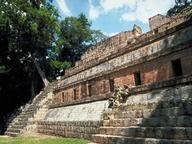Quiz Answer Key and Fun Facts
1. Real archaeology works just like "Indiana Jones and the Raiders of the Lost Ark."
2. So you want to begin an archaeological excavation. Which of these would be a good first step?
3. Research excavations have the same goals and timeframes as rescue excavations.
4. You conduct a site survey to decide where to start excavating. Which of these techniques would you NOT want to use?
5. You might not want to locate your dirt dump, or spoil heap, somewhere you're planning to excavate later.
6. Now you finally get to dig. What do you call that ubiquitous hole in the ground, the place where people are digging?
7. Every archaeologist keeps a notebook containing the record of everything that goes on at the excavation. Which of these is it NOT important to include in your notebook?
8. If you uncover a straight line of large stones, what do you write in your notebook?
9. You should never, EVER remove any structure to get to a lower level.
10. One of the tools you are likely to see at an excavation consists of a long tube filled with colored water and attached to a tape measure at one end. What is it?
11. Archaeology has its own set of terminology to describe what comes out of the ground. Take the term "small find." In Mediterranean archaeology which of these would *not* be considered a "small find"?
12. Can the potsherds indicate the time period of the area you are excavating?
13. Say you find a sherd of pottery on the ground outside your trench. What should you do with it?
14. So now you've finished another successful season of excavations. If you are the archaeologist, what should you do now?
15. You, too, can work at archaeological excavation!
Source: Author
pu2-ke-qi-ri
This quiz was reviewed by FunTrivia editor
bloomsby before going online.
Any errors found in FunTrivia content are routinely corrected through our feedback system.

